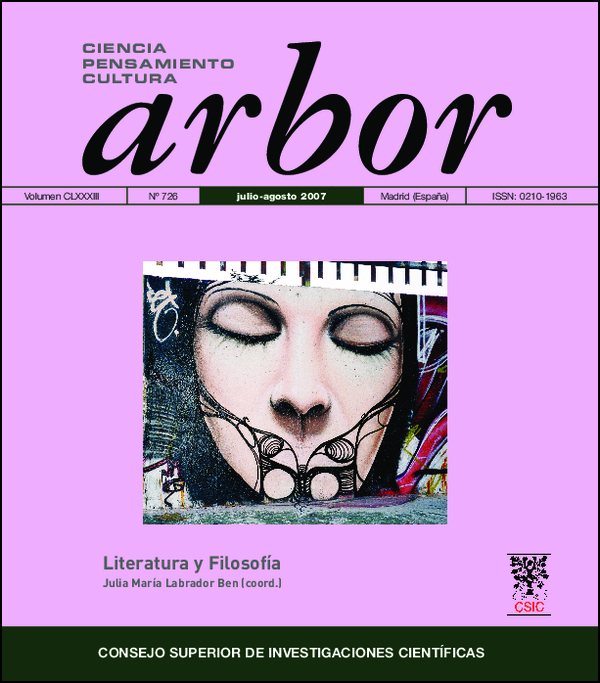“El cántaro” o la creatividad de lo vacuo en la poesía de José Ángel Valente
DOI:
https://doi.org/10.3989/arbor.2007.i726.123Keywords:
José Ángel Valente, androginia, taoism, “El cántaro”, vacuity, irony, negation, inmanencia, Knowledge poetry, Einstein, Ortega y Gasset, music, fugueAbstract
Through the commentary of “the pitcher”, one of the most important poems of Poemas a Lázaro (1960), studies the importance of androginia in Valente’s poetry and poetic. Taking the symbol from pitcher-song, Valente develops a sustained poetic theory in two fundamental concepts: negation and inmanencia. Both concepts lead to a poetry characterized by the fusion of semantic opposites like necessary step in the search of the poetic center. By all this, the impact in the Valente’s poetry of the opposition between essence/existence, realism/nominalism and relevance of the musical canon within the poetry of the orensano is analyzed. In this philosophical context, poetic and mystical, the poetry of Valente with the Taoism and the theory of the relativity of Einstein through a text of Ortega and Gasset is compared.
Downloads
References
Amorós Moltó, Amparo (1981): “El espacio en la poesía de José Ángel Valente”, Ínsula (412), p. 1.
Amorós Moltó, Amparo (1982): “La retórica del silencio”, Los cuadernos del norte (16), pp. 18-27.
Ancet, Jacques (1984): “Lindero, objetos de la noche”, Quimera (39-40), pp. 94-95.
Bousoño, Carlos (1961): “Poesía y originalidad”, Índice de artes y letras (150-151), p. 29.
Carreño, Antonio (1985): “Hacia una poética de la ‘mirada’: Poesía y percepción”, Ínsula (460), p. 19.
Castro Florez, Fernando (1991): “Sola raíz de lo cantable. Entrevista con José Ángel Valente”, Espacio/Espaço escrito (6-7), p. 19.
Cirlot, Juan-Eduardo (1994): Diccionario de símbolos, Barcelona, Labor.
De Man, Paul (1998): La ideología estética, Madrid, Cátedra.
Hernández Salván, Marta (2000): “Los límites del silencio en ‘Nadie’ de José Ángel Valente”, Tropelías. Revista de teoría de la literatura y literatura comparada (11), pp. 49-60.
Ihmig, Alexandra (1998): “El silencio de José Ángel Valente y Antoni Tàpies”, Quimera (168), pp. 14-25.
Izutsu, Toshihiko (1997a): Sufismo y taoísmo: estudio comparativo de conceptos filosóficos clave. vol. I. Ibn ‘Arabi, Madrid, Siruela.
Izutsu, Toshihiko (1997b): Sufismo y taoísmo: estudio comparativo de conceptos filosóficos clave. vol. II Laozi y Zhuangzi, Madrid, Siruela.
Ortega y Gasset, José (1983): Obras completas. vol. III, Madrid Alianza.
Peinado Elliot, Carlos (2002): Unidad y trascendencia: estudio sobre la obra de José Ángel Valente, Sevilla, Alfar.
Sánchez Moreiras, Miriam (1999): “Vacío y plenitud: el silencio poético entre la ‘lexis’ y el ‘logos’”, Voz y letra. Revista de literatura (2), pp. 111-131.
Sanchís, Nicasio (1994): “La poesía como arte de iniciación. José Ángel Valente, purificador de palabras”, Barcarola. Revista de Creación Literaria (46), pp. 302-306.
Valente, José Ángel (1971): Las palabras de la tribu, Madrid, Siglo Veintiuno de España.
Valente, José Ángel (1999a): Obra poética 1. Punto cero (1953-1976), Madrid, Alianza.
Valente, José Ángel (1999b): Obra poética 2. Material memoria (1977-1992), Madrid, Alianza.
Valente, José Ángel (2002): Elogio del calígrafo: ensayos sobre arte, Barcelona, Círculo de Lectores-Galaxia Gutenberg.
Valente, José Ángel (2004): La experiencia abisal, Barcelona, Círculo de Lectores- Galaxia Gutenberg.
Valente, José Ángel; Flores, Antonio (1987): La Mística: Presencia y Ausencia (Desde una lectura de Ibn ‘Al-Arif), Almería, Instituto de Estudios Almerienses, pp. 59- 60 y ss.
Downloads
Published
How to Cite
Issue
Section
License
Copyright (c) 2007 Consejo Superior de Investigaciones Científicas (CSIC)

This work is licensed under a Creative Commons Attribution 4.0 International License.
© CSIC. Manuscripts published in both the printed and online versions of this Journal are the property of Consejo Superior de Investigaciones Científicas, and quoting this source is a requirement for any partial or full reproduction.All contents of this electronic edition, except where otherwise noted, are distributed under a “Creative Commons Attribution 4.0 International” (CC BY 4.0) License. You may read here the basic information and the legal text of the license. The indication of the CC BY 4.0 License must be expressly stated in this way when necessary.
Self-archiving in repositories, personal webpages or similar, of any version other than the published by the Editor, is not allowed.














